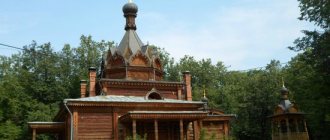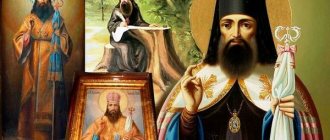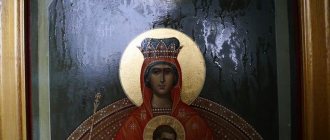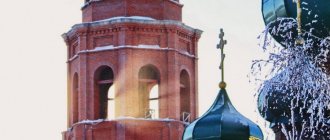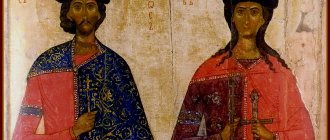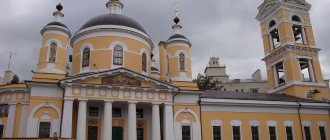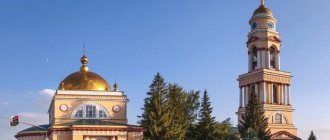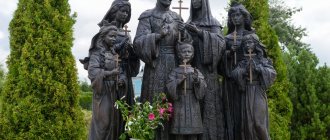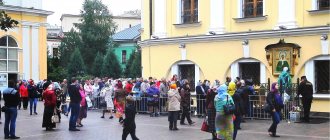The relics of St. Tikhon of Zadonsk - the history of the saint
In the world, Timofey was born into a peasant family with many children. Soon he became literate and studied at a theological seminary. He was one of the best students. He took monastic vows and received the name Tikhon. His life path is closely connected with God and serving people - at first he taught theology and Greek, and became the rector of a theological seminary.
Serving at the post
When the time came to choose the bishop of the Voronezh diocese, the lot fell three times on Tikhon. He accepted and successfully served in this post. During his service, he wrote theological books, took care of the spread of the Orthodox faith, and improved divine services. Colleagues and ordinary people always spoke positively about him.
Retirement and death
There are known cases of healing of demonic possession, serious illnesses and paralysis. Due to poor health, Tikhon retired and moved to live in a monastery in Zadonsk. The future saint did not disdain hard work and prayed tirelessly. Proshans often came to his cell, praying for healing. He spent the money he collected from the nobles on alms to the poor and needy.
At Tikhon’s favorite resting place there is a bathhouse and a nunnery. There is also a local legend that gives miraculous powers to the oak tree under which the saint rested. Alas, it is located on private property and access to it is closed.
The activist died there. During the testimony of honorary servants, Tikhon’s body was recognized as incorrupt. He is included in the list of Orthodox saints, although he was included there with a significant delay: the then reigning Nicholas I was afraid of any public meetings, seeing in them the possibility of rebellion.
Divine services in the monasteries of Zadonsk
The main action for which pilgrims go to Zadonsk is worship, the sacraments of Confession and Communion. The schedule of services of each monastery and church in Zadonsk has its own characteristics.
Schedule of services in Zadonsk monasteries:
| Time | Nativity of the Virgin Mary Monastery | Theotokos-Tikhonovsky Monastery (Tyunino) | St. Tikhon's Transfiguration | |
| St. Vladimir's Cathedral | Church of the Nativity of the Virgin Mary | |||
| 2:45 | Early liturgy (Sundays, holidays) | |||
| 5:40 | Sister's prayer service to Tikhon of Zadonsk | |||
| 5:45 | Middle liturgy (Sunday, holidays) | |||
| 6:00 | Morning prayers. Midnight Office. Akathist | Morning prayers. Midnight Office. Akathist to the icon "Life-Giving Spring" | Morning prayers. Midnight Office. | |
| 7:00 | Late Liturgy | Watch. Liturgy. Prayer services | ||
| 7:30 | Liturgy | |||
| 8:00 | Liturgy (Sunday) | |||
| 9:30 | Prayer service | |||
| 10:00 | Memorial service | |||
| 12:00 | Prayer service with akathist at the relics of St. Tikhon | |||
| 13:00 | Unction (Assumption Church, Saturday) | |||
| 16:00 | Evening service | Evening worship. Akathists | ||
| 16:40 | Vespers. Matins | |||
| 16:50 | All-night vigil with blessing of oil (Saturday, holidays) | |||
Advice. In all the monasteries of Zadonsk you can order services: remembrance of health and repose, magpies, prayer services with an akathist and blessing of water, the Indestructible Psalter. It is more convenient to register them on the monastery website than to stand in a long line and waste precious time during the pilgrimage.
Where are the relics of Tikhon of Zadonsk?
The relics of Saint Tikhon of Zadonsk were officially examined on May 19, 1860. The coffin was opened and it was discovered that the boards themselves had rotted and become rotten, but the body had been preserved almost completely. Acceptable changes were recorded:
- the skin has turned brown;
- The joints of the arms and legs separated slightly, but did not separate from the body.
The opening took place on August 13 - today is the saint's feast day. Under royal rule, the relics were venerated and buried in different monasteries depending on the time of year. During Bolshevism, the relics were taken from the city to a special anti-religious museum. After the Second World War they were exhibited in Orel in the Epiphany Cathedral.
In October 1961, the remains were again hidden away from human eyes in the rooms of the local history museum. At the end of the 1990s. petitions began for the return of former buildings to existing churches. The body shriveled and mummified, but the left hand remained almost incorrupt.
Today the relics of Tikhon of Zadonsk are in the Zadonsk Nativity of the Theotokos Monastery. A beautifully decorated canopy is installed above them. The relics heal from mental, physical and moral ailments.
Mother of God-Tikhonovsky (Tyuninsky) Monastery
The location of this monastery is also associated with the name of Tikhon of Zadonsk, who fell in love with a spring in the wilderness, 3 kilometers from the Zadonsk Monastery. The source was ennobled and equipped by the hands of the saint - it is the main shrine of the women's monastery. In 1814, a house church was built here in honor of the “Life-Giving Spring” icon. The complex of the Tyuninsky Monastery (the name comes from the name of the landowner - the owner of these lands in the 17th century) in addition to this temple includes the majestic Ascension Cathedral, the Church of Alexander Nevsky, a four-tier bell tower, and a pilgrim's house. The monastery is home to 30 sisters, headed by Abbess Arsenia.
Mother of God-Tikhonovsky (Tyuninsky) Monastery
Official website of the Tyunin Monastery: https://tunino.ru.
How does prayer near the relics of Saint Tikhon help?
A commission organized by the Holy Synod checks and records all cases of healing at the relics of Tikhon of Zadonsk.
People exhausted by illnesses come to the tomb with many diseases:
According to the testimony of those healed, the answer to eye diseases comes more often. This is how a boy who was blind after an illness was healed, and a woman’s growth on her eye disappeared right during prayer.
Near a place illuminated by God, the blind see, and the deaf begin to hear. Patients with cholera, cirrhosis of the liver, and women suffering from bleeding sought help and received healing from the Monk Zadonsky. The Patriarch of Zadonsk appeared to many who asked during sleep, after which the sick woke up completely healthy.
Treatment of the possessed is a problem even for modern medicine, but not for the healing power of the relics of the monk. Pelageya Gavrilova was born a healthy girl, but after her marriage she was possessed by demons. Relatives brought the sick woman to churches, but she became even more furious there, screaming in different voices. Only after visiting the Zadonsk Monastery, where a memorial service for St. Tikhon was celebrated, and receiving communion, the woman was released.
Church books keep records of liberation from paralysis, muteness, hemorrhoids and hysterical seizures.
Zadonsky Nativity of the Theotokos Monastery is the last refuge of St. Tikhon of Zadonsk.
Source
Great preacher and healer
At the beginning of the 17th century, elders Cyril and Methodius from the Moscow Sretensky Monastery founded the Zadonsky Monastery of the Mother of God. Among the shady gardens, in the thicket of the forest, on the banks of the Don River, in the blessed silence, stands the monastery of God, where St. Tikhon arrived in 1769.
Growing up in an extremely poor family and often starving as a child, the boy managed to graduate from theological seminary and took monastic vows in 1758, realizing his youthful dream.
The young man was distinguished by amazing patience, obedience and efficiency. Spiritual perfection contributed to rapid career growth. In 1759, Tikhon was elevated to the rank of hieromonk, and in 1761 he was already Bishop of Kexholm and Ladoga. In 1763, the saint headed the Voronezh diocese. Paying great attention to the fight against heresies and paganism, restoring seminaries and Sunday schools, receiving and praying for parishioners. Saint Tikhon constantly received parishioners, fed the poor, and personally gave the sick medicinal teas.
A hungry and cold childhood made itself felt; the 40-year-old rector of the diocese was often ill and asked for his resignation, wanting to retire. The last refuge of the Monk Tikhon was the Zadonsk Monastery, in which the once rector of the diocese, having sold rich clothes and silver, distributed everything to the poor, lived like an ordinary monk, showing an example of patience, forgiveness and brotherly love.
Interesting! The brethren knew about his miraculous prayer during illness; often the monks were healed by his word alone. For his humility and reverence for God, the Creator rewarded the novice with the gift of clairvoyance; he predicted the time of his death, resting on August 13, 1783.
In the saint's notes, predictions of war with the French and the great St. Petersburg flood were found.
Prayer to Tikhon of Zadonsk
O all-praised saint and saint of Christ, our Father Tikhon! Having lived like an angel on earth, you, like a good angel, appeared in your wondrous glorification. We believe with all our souls and thoughts that you are our merciful helper and prayer book, with your honest intercessions and the grace abundantly given to you from the Lord, ever contributing to our salvation. Accept therefore, blessed servant of Christ, even at this hour our unworthy prayer: free us through your intercession from the vanity and superstition that surrounds us, the unbelief and evil of man. Strive, quick intercessor for us, to beg the Lord with your favorable intercession, may He add His great and rich mercy to us, His sinful and unworthy servants, may He heal with His grace the incurable ulcers and scabs of our corrupted souls and bodies, may He dissolve our petrified hearts with tears of tenderness and contrition for our many sins and may He deliver us from eternal torment and the fire of Gehenna; May He grant to all His faithful people peace and quiet, health and salvation, and good haste in everything, so that having lived such a quiet and silent life in all piety and purity, let us be worthy to glorify and sing the all-holy name of the Father with the Angels and with all the saints, and the Son and the Holy Spirit forever and ever. Amen.
Life of Tikhon of Zadonsk
Saint Tikhon of Zadonsk was born in 1724 in the Novgorod province. Having lost his father early, he earned his own living. “In our mother’s house there were four brothers and two sisters.” Poverty in the family was terrible. “It happened that when there was nothing to eat in the house, I spent the whole day harrowing a rich man’s arable land just to be fed with bread.”
In December 1738, at the request of his older brother, he was enrolled in the Novgorod Theological Slavic School at the bishop's house, and 2 years later, as one of the most capable of science, he was transferred to the government's pay to the newly opened seminary. This allowance meant that in addition to free lessons, he could receive bread and boiling water for free. “It used to be that when I received bread, I would keep half for myself, and sell the other and buy a candle, with which I would sit at the stove and read a book. My comrades, the children of rich fathers, will find my bast shoes and begin to laugh at me and wave their bast shoes at me, saying: “We magnify you, holy saint!” Who would have known that these mocking words would turn out to be prophetic! He spent fourteen years within the walls of the theological seminary, first studying theology, and then teaching various disciplines and heading the department of rhetoric. The young teacher, distinguished by his extraordinary cordiality, modesty and pious life, was very much loved and respected by everyone - the students, the seminary authorities, and the Novgorod bishops.
Tikhon Zadonsky was engaged in educational activities
On April 16, 1758, on Lazarus Saturday, Timothy became a monk with the name Tikhon. And a year later he was appointed archimandrite of the Tver Zheltikov Assumption Monastery and rector of the Tver Theological Seminary, a teacher of theology and a member of the spiritual consistory.
At this time, he became a bishop - on May 13, 1761, in the St. Petersburg Peter and Paul Cathedral, he was consecrated Bishop of Kexholm and Ladoga, vicar of the Novgorod diocese. The new obedience assigned by the hierarchy called him to St. Petersburg to preside over the St. Petersburg Synodal Office. From there, Bishop Tikhon moved further to Voronezh, where at that time Bishop John of Voronezh and Yelets died, and Bishop Tikhon was appointed to the Voronezh see.
At the Voronezh see, Saint Tikhon of Zadonsk launched large-scale activities; previously, only to the extent of the opportunities given to him by teaching, he disseminated true knowledge about God among the laity and clergy, encouraging them to pure faith. Now he could write and publish theological works, preach, observe and help the clergy in their ministry. In the very first year of his priestly ministry in Voronezh, Bishop Tikhon wrote a short teaching “On the Seven Holy Mysteries.” This was followed by the work “Addition to the Priestly Office on the Mystery of Holy Repentance.” This work is of particular interest because in it the saint teaches two approaches to constructing a confession for the laity: feeling a person’s deep repentance and contrition for his sins, the clergyman must encourage and console him, reminding him of God’s mercy and forgiveness in order to prevent the penetration of despondency in his heart. The writings of Tikhon of Zadonsk seem extremely simple. Saint Philaret of Moscow, in a conversation with Ignatius Brianchaninov, said that the writings of Tikhon of Zadonsk are “a shallow river, but there is golden sand in it.”
Vladyka constantly participated in the education of future archpastors, opening Slavic schools in all cities, and then establishing two theological schools in Ostrogozhsk and Yelets. In 1765, through his works, the Voronezh Slavic-Latin school was transformed into a theological seminary. At the same time, the bishop was the first to prohibit corporal punishment of clergy in his diocese.
The incorrupt relics of the saint
In 1845, during the construction of a new church, the tomb of the saint was opened, and his relics turned out to be incorrupt. Sacred joy and reverence gripped everyone present.
The priests were afraid of the large crowd of people and quietly carried out the reburial, which was performed in the Church of the Nativity of the Virgin Mary,
Only 16 years later, on the day of the death of St. Tikhon of Zadonsk, he was canonized. While the top cover was being removed, the temple, filled with several tens of thousands of people, froze in silence; the Christians slowly sank to their knees and froze in silent weeping.
Terrible times awaited the Vladimir Monastery during the years of the revolution, when the Red Army soldiers opened the tomb and took the relics to Oryol, to the museum of religion. At the same time, they made a film supposedly exposing the incorruptibility of bones, calling everything a lie of religion.
All churches in Zadonsk were closed, many priests were either shot or sent into exile. The surviving monks, faithful to their shrine, returned to the holy place, and after Stalin’s permission to open the temples, they began worship.
By chance, Father Victor found an icon of Patriarch Tikhon in the attic of one of the houses, where he was drawn in full growth, which became the main shrine of the open church.
In 1959, a new commission was created, which confirmed the incorruptibility of the relics. The then ruler of the USSR, N.S. Khrushchev, did not like this; in 1961, the holy remains were again transferred to the museum’s storage facility.
